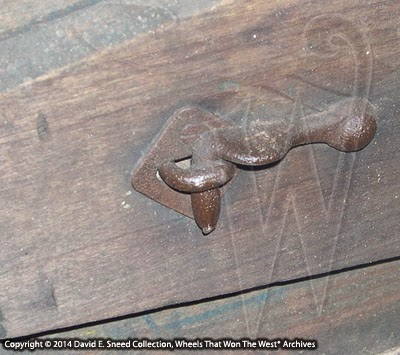Over and over, I’m asked how to determine the identity of a wagon when
the maker name is lost or worn away.
Rarely is there a simple response, although I've often wished for one. Answers can lie in a number of places with
firsthand experience often landing at the top of the list. During the last two decades, I’ve been
privileged to examine thousands of pieces and those encounters can be a tremendous resource in any review. An equally important asset is the amount of
original builder literature we have in our Wheels That Won The West® Archives. Done correctly, these
assessments involve an overlay of the vehicle with numerous primary source materials,
using them as a solid and supportable measure of individual vehicle
features.
Since time can result in adaptations to even the most seemingly
correct pieces, the identification process requires that elements of the box
and gear be studied closely to help confirm a maker as well as levels of
authenticity. In a nutshell, there are
three areas that must be thoroughly evaluated in order to reach a supportable
conclusion in any reliable evaluation.
Those segments involve the original surviving portions of a wagon’s
paint, wood, and metal work. Each area
can offer numerous clues pointing to a possible maker. Likewise, each area is suspect until the
originality of the specific piece can be resolved.
 |
This small section of a pre-1900 illustration provides well over a dozen accurate clues pointing to a particular maker. |
I’ve written this blog as a reminder of the potential disappointments
waiting when quick determinations are based solely on superficial details. In particular, transitory pieces like end
gates, spring seats, tongues, and doubletree/singletrees cannot be looked upon
as singularly conclusive sources of a wagon’s identity. Even the box should be reviewed to assure a
match to the running gear. The
reason? Over the years, these pieces can
become separated with substitutions easily made. While each of these parts can support maker
details noted elsewhere on the wagon, no solitary part should ever by relied
upon as confirmation of an entire vehicle’s identity.
As I’ve shared in previous writings and event presentations, there are
literally hundreds of differences that can be pointed out between different
brands of farm, freight, and ranch wagons.
From axle shapes and bed measurements to box rods, hound configurations,
wheel designs, circle irons, and so much more, the amount of subtle but crucial
differences can be staggering. Over the
years, I’ve catalogued at least three dozen potential variations in just the
spring seats alone. Multiple
considerations involving the seat hangers, spring designs, support blocks,
bracing elements, and shape of the seat back go well beyond the basic
measurements and are just a few points that help confirm whether a piece is
both correct for the maker as well as the era represented by the rest of the
wagon.
 |
Period photos combined with early literature can prove invaluable when authenticating seats and other elements of surviving wagons. |
Endgates are another constant source of contention. Because they are easily removed and can be
replaced over time, it often requires the assistance from numerous primary
source materials to confirm everything from hardware and special features to
position and overall design. Over and
over, I’ve wished the subject were simpler but, the fact remains, these early
wagons were (and are) complex machines designed for even more challenging
work.
 |
Knowing the correct hardware and woodwork configurations for a particular brand (and particular era) is essential to the serious collector of early wagons. |
From the beginnings of my own collecting, my desire has been to help
preserve the highest levels of originality in early wagons and western
vehicles. Ultimately, it’s a service to
future generations for each of us to help pass along the greatest truths of
these wheeled workhorses. Likewise, for
a person desiring to collect truly original pieces, this information is vitally
important as it directly impacts the perceptions, integrity, and sustainable
worth of a set of wheels.
